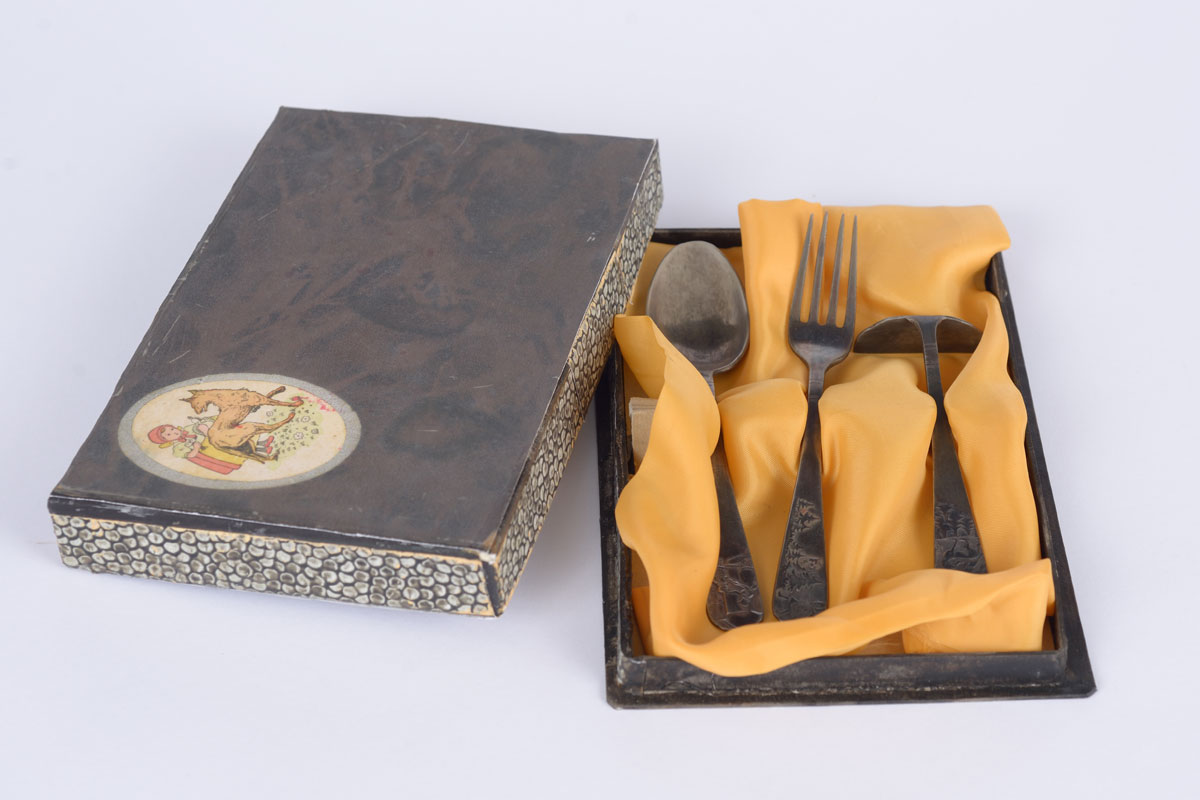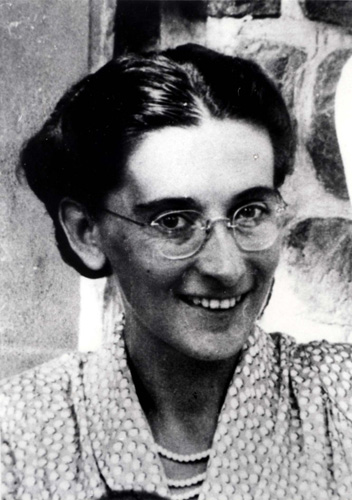- Interview with Mirjam Waterman, O.93/3564, Yad Vashem, Jerusalem. Originally interviewed at the USC Shoah Foundation Institute.
Introduction
In this section we focus on artifacts, presented courtesy of the Artifacts Retrieval Department, that can inform us about a specific part of the Holocaust period. These items, which are part of the Yad Vashem collection, are unique: they characterize events that occurred during the Holocaust, and hold emotional value as well. The story of these artifacts is accompanied by points of reference and discussion to be used with students. This article was first published in Hebrew in our October, 2008 newsletter, then appeared in the English edition of Teaching the Legacy (March, 2009). The Hamerslags' utensil set and coat invite us to learn about the smuggling of children, the Netherlands, concentration camps, Righteous Among the Nations, and more.
The Story
In May, 1943, Mirjam Waterman, a member of the Dutch Underground resistance movement, arrived at the Amstel train station in Amsterdam. In tow were two young orphans – Miriam and Henri (later Zvi) Hamerslag, a one-and-a-half year old girl and her baby brother. Their parents, Amalia and Karel Hamerslag, had been taken to the Westerbork transport camp and from there to the death camp Sobibor, where they were murdered. Mirjam placed the baby stroller in line with other strollers outside the platform, and it was soon picked up by another woman. What makes this story unusual is that Mirjam had never met the woman who would take these two children into hiding.
In the summer of 1942, with the beginning of the deportation of Dutch Jews to death camps, several organizations were established to find hiding places for Jews. Many contacts used by these organizations worried about being caught with counterfeit money or forged identity cards, and in some cases were also concerned with the risks of moving from one place to another. One extraordinary undertaking was the rescue of children. In total, 4,500 children were hidden, and very few were discovered by the Nazis. The largest group that dealt with the hiding of children was the Westerweel group that worked together with other pioneering organizations. Though we do not know exact figures, it is clear that there was a significant number of Jews in the Dutch Underground.
Within the framework of the Dutch Underground's activities, Mirjam Waterman worked to rescue children. She took babies from parents who were scheduled to be deported, or who were already deported to Westerbork, and brought them to the train station. In a similar fashion to that described above, the babies were then given to the contact person who continued by train. In order to protect the mission and members of the Underground, complete secrecy was necessary. For that reason, Mirjam did not know where she was sending the babies, or the identity of the woman who took them. Afterwards, Mirjam was able to slip out of the train station without arousing suspicion, because she left the stroller at the back of the line, and was not spotted leaving with an empty stroller.
After the train journey, Miriam and Zvi arrived at the children's house in Hilversum. A young Jewish woman, also a member of the Underground, was put in charge of their care, as she was hiding there as well. About two weeks after the children arrived, Mirjam Waterman came to visit a friend at the children's house, and was amazed to see the two babies whom she had helped save. She later recounted, "Many children were hidden in the children's institution managed by Katy Mulder. Among them was Kittie Frank, one of the women who had been under my care. In one of my visits to the institution, Kittie took me into her room and said, 'I have been given an additional task – to care for two babies who just arrived.' When she showed me the babies I knew that it was the brother and sister who I had just transferred at the train station. The girl, Miriam Hamerslag, was one-and-a-half years old, and the boy was two weeks old."1
During the war, Mirjam Waterman was caught and sent to Bergen-Belsen, where she lived under harsh conditions for more than a year, until her liberation. After liberation, Mirjam began working for Jewish agencies to help return children to any surviving relatives. The process was difficult and at the end the children were found and transferred to Jewish orphanages. In 1949 the two children featured in this story made aliyah [immigrated] to Israel and were adopted by the Araten family in Haifa.
- 1. 1
By the 1980s Miriam and Zvi had grown up, married, had families of their own, and had located Henriette "Hetty" Voute, the woman who had taken them on the train. In 1988 Hetty received the designation as Righteous Among the Nations for her efforts as a rescuer. Zvi and Miriam kept in touch with her until her death in 1999. Due to her activities within the Underground, Hetty had been caught and sent to the Ravensbrück concentration camp. In fact, Hetty's name was discovered on a red tapestry covered with the names of camp prisoners, donated to Yad Vashem by a survivor of Ravensbrück.
Katy Mulder, director of the institution in Hilversum, was beloved by the children. She wrote them a goodbye letter before she was taken from the children's home, and continued to be in touch with them until she died. All those years she had kept the coat in which Miriam had been wrapped, as well as the utensils that had been sent with the children. Katy was recognized after the war as Righteous Among the Nations for her actions.
Katy decided to give the utensils to the "children" in Israel and they remained with Zvi throughout his life. The coat was given to Mirjam Waterman (who married Menachem Pinkhof).
The information and photographs about these artifacts were collected as part of the testimony given by Mirjam (Waterman) Pinkhof, Zvi (Hamerslag) Araten, and Miriam (Hamerslag) Zelach.
Topics for Classroom Discussion
Designed for junior high school and high school students, these discussion points may be used as the teacher sees fit in accordance with the level and emotional capability of the class. The following questions deal with the items themselves as well as the act of rescue.
- Look at the photograph of the eating utensils. How do we know that these were utensils for babies and young children?
- In the photograph it is clear that we are looking at a personal set of utensils (fork, knife, spoon) decorated with pictures from the children's story "Little Red Riding Hood." The set sits in a special box, with an illustration from the story on the cover.
- Why did Miriam and Zvi's parents choose to send them with this cutlery?
- It is possible that parents wanted to send their children with an item that would remind them of home and family. Perhaps they also thought that no one would find such silverware suspicious so it was safe to send.
- It is possible that the parents chose to send a set of silverware because it is easily moved from place to place.
- Perhaps their parents wanted to leave a positive message and a legacy for their children. Like in the children's story, maybe their own reality would conclude with "happily ever after" and a reunited family.
- Maybe it was a practical decision. The parents chose an item that would be useful for their children, either to eat with or to pawn in order to save their lives.
- Do you remember the first set of cutlery that you used as a baby? Did your parents save them for posterity?
- Children's silverware begins to be used while babies are very young, generally even before they begin to speak or walk. This artifact is a memento from early childhood, a significant phase in development, which we often do not remember. Therefore, an item from this period is meaningful and a way to remember one's childhood.
- In your opinion, what meaning do remaining objects hold for the surviving children? Do the objects then attain additional significance?
- Zvi (Hamerslag) Araten loaned but did not donate his silverware to the Holocaust History Museum at Yad Vashem. In this context you may ask your students: Why are many of the artifacts that survived the Holocaust loaned to the Yad Vashem museum and not given as gifts? You might also lead a discussion on the emotional worth of an item, because in many situations, individuals remained alone without parents or a family.
These questions refer to Mirjam Waterman, who rescued Jewish children:
- In your opinion, what motivated Mirjam Waterman to work in the Dutch Underground and to help people?
- What difficulties did she face in her rescue efforts?
- Transportation of children had to be carried out secretly. The transporting of small children and even of babies was dependent upon their cooperation and behavior, things which cannot be predicted and can greatly endanger the rescuer. Additionally, the nature of the action could have attracted the attention of surrounding people.








